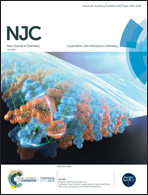Selective hydrogenation of nitroarenes to amines by ligand-assisted Pd nanoparticles: influence of donor ligands on catalytic activity†
Abstract
Ligand-assisted synthesis of metal nanoparticles has advanced significantly; however, the influence of donor groups on the catalytic performances of such heterogeneous systems has not been systematically explored. Here, we have synthesized and characterized three ligand-based silica-supported palladium nanocatalysts via an impregnation-reduction method through anchorage of palladium onto silica gel functionalized with amine, phosphine and thiol. TEM images of the amine- and phosphine-based materials showed formation of uniformly distributed palladium nanoparticles (Pd NPs) with fine particle sizes, whereas the thiol-based material showed formation of palladium nanowires (Pd NWs) of irregular sizes. To investigate the influence of the donor ligands, selective hydrogenation of 4-chloronitrobenzene (4-CNB) to 4-chloroaniline (4-CAN) was carried out. Under similar experimental conditions, the catalytic activity decreased in the order of phosphine > amine > thiol. A maximum yield of 98% and selectivity of 100% was achieved with the phosphine-based catalyst using molecular hydrogen as a reducing agent. A diverse range of nitroarenes were efficiently converted to their corresponding amines.



 Please wait while we load your content...
Please wait while we load your content...